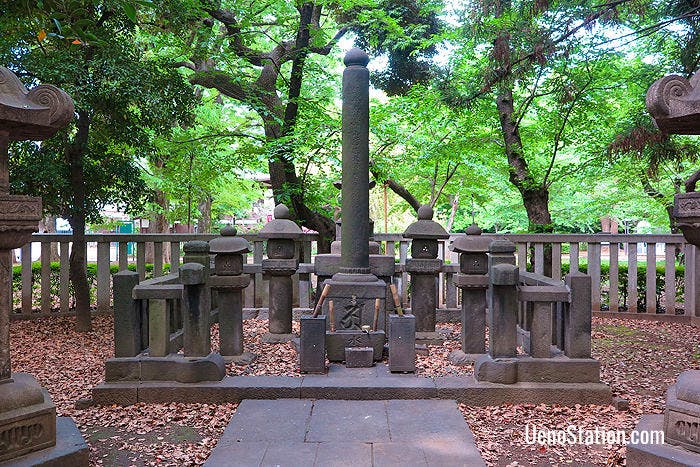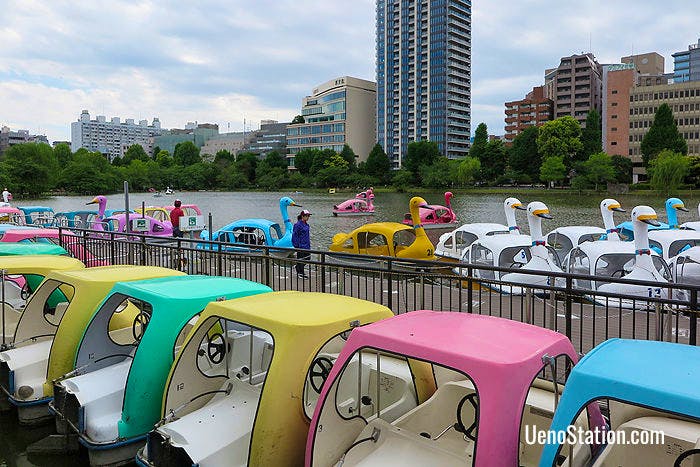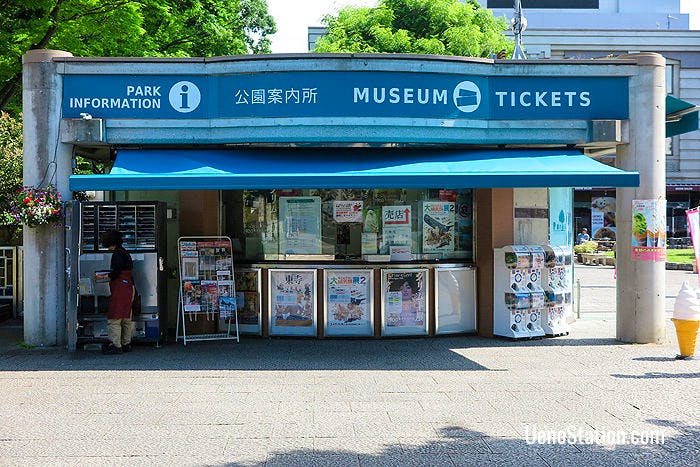Ueno Park is a large public park in Tokyo’s Ueno district. Famous for its cherry blossoms in the spring, the park is an extraordinary location where natural beauty is combined with a wealth of cultural and recreational facilities, historic sites, and monuments.

Inside Ueno Park
Within the park’s expansive grounds are a zoo, six museums, a concert hall, several temple buildings and shrines, and a large pond with boating facilities. In fact there is so much to see here that you could easily devote two or three days to exploring everything. If you don’t have so much time, then take a look at the guide below and pick out the sights and locations that appeal to you the most.
History
Ueno Park is located on a wooded plateau to the west of JR Ueno Station which is called Ueno Hill. This entire area was once the site of a massive temple complex called Kaneiji Temple. However, in 1868 there was a big battle in Ueno between forces loyal to the shogun (the military ruler of Japan), and imperial forces that wanted to restore the emperor to power. The imperial forces won easily, but the battle caused a fire that destroyed most (but not all) of the temple buildings. After that Ueno Hill became the property of Tokyo city’s government, and in 1871 proposals were put forward to build a hospital and a medical school there. A Dutch military doctor named Anthonius Bauduin was sent to inspect the land at that time, but instead of confirming its suitability for construction, he began to petition the government to open a park. Bauduin must have had some influence, because as a result of his efforts Ueno Hill was designated as one of Japan’s first public parks in 1873.
Cultural Facilities
Here is a list of the cultural facilities located inside Ueno Park. Click on the links for more detailed information. It is worth remembering that most of these locations are closed on Mondays.
- Ueno Zoo is located on the west side of the park. This major zoo is famous for its giant pandas and is one of Ueno’s main attractions.
- Tokyo Bunka Kaikan is a concert hall just inside the main entrance of Ueno Park which hosts a variety of opera, ballet, and orchestral performances.
- The National Museum of Western Art stands across from Tokyo Bunka Kaikan and exhibits an outstanding collection of paintings and sculptures that cover seven centuries of Western art history.
- Tokyo National Museum is a massive museum complex in the northern part of the park which houses and exhibits Japan’s most significant and impressive collection of art and antiquities.
- The National Museum of Nature & Science is a fantastic museum in the park’s north-east corner which is packed with dinosaur exhibits, interactive displays, and historic items such as an actual rocket launcher, and a steam locomotive.
- Tokyo Metropolitan Art Museum is a contemporary art museum with a rich and diverse schedule of special exhibitions and themed art shows.
- Ueno Royal Museum is a private art museum that puts on regular special exhibitions in a variety of genres.
- The Shitamachi Museum is dedicated to preserving and exhibiting Tokyo’s downtown culture and history with detailed recreations of streetscapes and living spaces.

Tokyo Bunka Kaikan
There are also some important cultural facilities just outside the park’s western exit. These include:
- Kuroda Memorial Hall is a small museum which exhibits the paintings of the Western-style artist Kuroda Seiki. Entry to this museum is completely free.
- The University Art Museum, Tokyo University of the Arts is only open for special exhibitions but among the museum’s collection are many modern masterpieces which include 22 National Treasures and Important Cultural Properties.
- The International Library of Children’s Literature is a free facility which includes a children’s library and a museum which hosts a range of exhibitions and events.
A Sightseeing Tour of Ueno Park
Ueno Park contains a large number of historic sites, monuments and recreational facilities. Among the sites of historic interest are some of the Kaneiji Temple buildings that survived the Battle of Ueno in 1868, as well as monuments to those who fought in that battle.

The bronze statue of Saigo Takamori
Entering the park from its southern entrance you will soon see the famous statue of Saigo Takamori (1828 – 1877). Saigo Takamori was the general who led the Imperial army to victory in the Battle of Ueno and this statue was erected here in his honor in 1898. The statue depicts him wearing simple clothes as if he is out hunting rabbits with his pet dog, whose name was Tsun.

The tomb of the Shogitai
Not far behind the statue of Saigo Takamori is the tomb of the Shogitai. The Shogitai were the samurai who fought for the shogun and most of them lost their lives in the Battle of Ueno. About 300 Shogitai are believed to have died here, and this tomb was erected in their memory by a small number of survivors in 1874.

The Hair Pagoda of Tenkai
Walk further north and you will find Ueno Royal Museum on your right and an unusual stone monument on your left. This is a stone pagoda which was erected to honor the memory of the monk, Tenkai (1536-1643). Tenkai founded Kaneiji Temple in 1625 and this pagoda contains a relic of his hair.

Kiyomizu Kannondo
Just behind Tenkai’s Hair Pagoda is Kiyomizu Kannondo. This is one of the surviving buildings from Kaneiji Temple and it was first established by the monk Tenkai in 1631. With its Main Hall standing on a raised veranda, Kiyomizu Kannondo resembles a smaller version of Kiyomizu-dera Temple in Kyoto, and it was in fact modelled on its famous Kyoto counterpart. The Main Hall enshrines a statue of the thousand-armed Kannon, who is the Buddhist goddess of Mercy. However, this statue is only shown to the public once a year for one day in February. This building is a nationally designated Important Cultural Property of Japan. Just in front of the veranda is a pine tree that has been trained to grow in a loop. The tree is called tsuki-no-matsu or “pine of the moon”, and if you look through the loop of the tree you can view Shinobazu Pond and the island temple of Bentendo.

Toki-Wasureji-no-To
Not far from Kiyomizu Kannondo is a memorial to all those who died in the Great Tokyo Air Raid during World War II. Walking through the pleasant leafy paths of Ueno Park today it is hard to imagine such a great historical tragedy, but the firebombing of Tokyo on March 10th 1945 killed an estimated 100,000 people and left a million homeless. This memorial was raised in 2005 to remind people of Tokyo’s sad history, and to encourage a peaceful future. The memorial includes a solar-powered clock and is called Toki-Wasureji-no-To which means “The Time Unforgotten Tower.”

A view over the Lotus Pond and the Bentendo Temple
Shinobazu Pond occupies a large area in the south of Ueno Park. The pond’s entire surface area covers 110,000 sq. m, but it is divided into three parts. To the south is the Lotus Pond which in the summer is completely covered in flowering lotus plants. To the east is the Boat Pond which has a rental boat service. And to the north is the Cormorant Pond which is mostly contained within Ueno Zoo, and is the home of a variety of bird life as well as cormorants. Walkways run between the ponds and meet in the center on the Bentenjima Island. On this island is the Bentendo Temple, which is another one of the surviving buildings from Kaneiji Temple. This temple is dedicated to Benzaiten the Buddhist goddess of music, wisdom, and wealth. The Bentendo is famous for its eight-sided tower which is clearly visible across Shinobazu Pond.

Rental boats at Shinobazu Pond
Three kinds of boats are available to rent on the Boat Pond. Row boats can hold three people and can be rented for 1 hour for 700 yen. Cycle Boats are pedaled like bicycles. These hold two people and can be rented for 30 minutes for 600 yen. Swan Boats are pedaled like the Cycle Boats but can hold three people. These cost 700 yen for 30 minutes. The rental service is open between 10.00 and 18.00 and between December and February it is closed on Wednesdays.

The Outdoor Stage
On the south side of Shinobazu Pond there is an outdoor stage with seating for around 1,200 people that hosts occasional music performances and summer festivals.

The torii gates of Hanazono Inari Shrine
If you return to the northern side of Shinobazu Pond, and go just a little to the west of Toki-Wasureji-no-To you can find two small shrines. Hanazono Inari Shrine can be reached through a picturesque tunnel of red torii gates. This shrine is dedicated to the god of rice, Inari, but nobody knows when it was first built. People pray here for good relationships with friends, lovers, and marriage partners.

Hanazono Inari Shrine’s main building, called the Honden, is guarded by fox statues
Right beside Hanazono Inari Shrine is Gojoten Jinja Shrine. This shrine is believed to be over 500 years old and is dedicated to the gods of medicine.

Gojoten Jinja Shrine
The biggest shrine in Ueno Park is the Toshogu which is a 4 minute walk from Gojoten Jinja. This 17th century shrine is famous for its historic buildings which are decorated with gold leaf and for its peony garden.

Ueno Toshogu Shrine
Standing beside the grounds of the Toshogu is a five-storied pagoda which is another of the surviving buildings of Kaneiji Temple. The pagoda was first built in 1631, and after being burnt in a fire it was rebuilt in 1639. Although the pagoda now stands on the grounds of Ueno Zoo, you can clearly see it from the grounds of the Toshogu which are free to enter.

The Five-Storied Pagoda of Kaneiji Temple
Just outside the Toshogu Shrine is a huge stone garden lantern which was originally donated to Toshogu Shrine in the year 1631. The lantern stands an impressive 6 meters high, and because of its size has been called the “Obake-Doro” or “Monster Lantern”.

The 17th century Monster Lantern
There is a small hill to the south of the Monster Lantern which is called Daibutsu-yama or “Great Buddha Hill” because it used to be the location of a giant bronze statue of a seated Buddha. The Great Buddha of Ueno was first erected in 1631, and then restored several times after an earthquake in 1640, a fire in 1841, and another earthquake in 1855. Finally in the Great Kanto Earthquake of 1923 the head of the statue came off, and the body of the Buddha was melted down during World War II. If you climb to the top of the hill though, you can see the face of Ueno Daibutsu which was preserved and put on display here in 1972.The face of Ueno Daibutsu and the pagoda that stands beside it are open to the public between 10.00 and 16.00.

The face of Ueno Daibutsu

The Daibutsu Pagoda
Just a little to the north of Daibutsu-yama is a dramatic statue of a man on horseback. This is Prince Komatsu Akihito (1846 – 1903) who was an important army leader during the war that restored the emperor to power in 1868. Prince Komatsu is also remembered as the first president of the Japanese Red Cross Society.

The statue of Prince Komatsu
The statue of Prince Komatsu stands in the center of of Ueno Park. To the north are three museums, to the west is Ueno Zoo, and to the east is Tokyo Bunka Kaikan and the National Museum of Western Art. If you are not tired of walking, then there is still a lot more to explore.
Dining Facilities in Ueno Park
There are several cafes and restaurants within the grounds of Ueno Park. For a full guide, please see our article Dining in Ueno Park.

The Park Side Café is located in the center of Ueno Park
Information
Ueno Park has several entrances and exits but the main entrance is just across from the Park Exit of JR Ueno Station. Just inside this entrance you can find an Information Office where you can pick up a free map of the park grounds. There are also large maps posted around the park to show your current location, and plenty of signage for the main sites and facilities.

The Park Information Office
Location
Ueno Park is convenient for JR Ueno Station, Keisei Ueno Station, and Ueno Subway Station on the Tokyo Metro Ginza and Hibiya Lines.
Article and original photos by Michael Lambe. All rights reserved.
